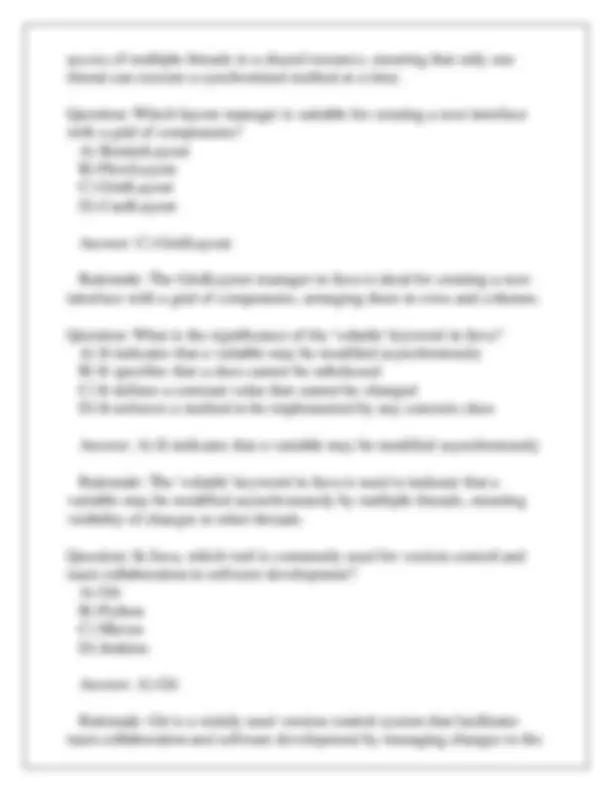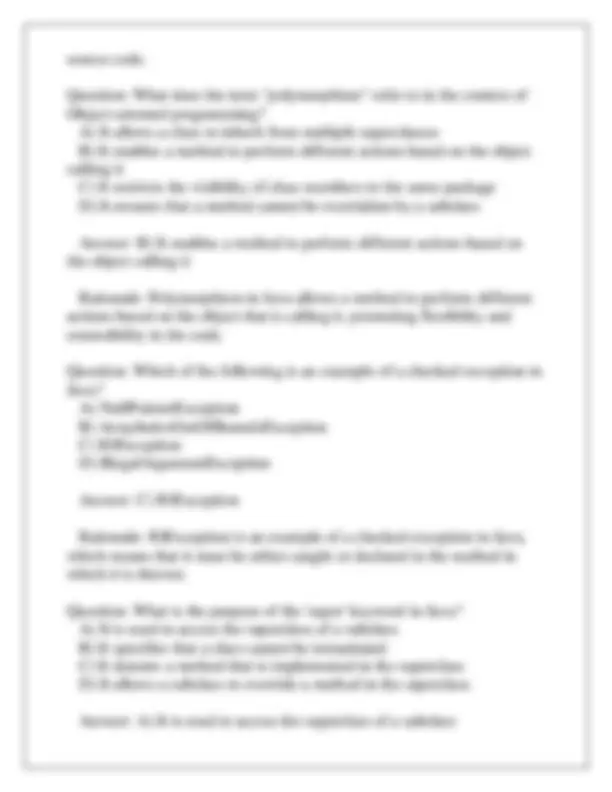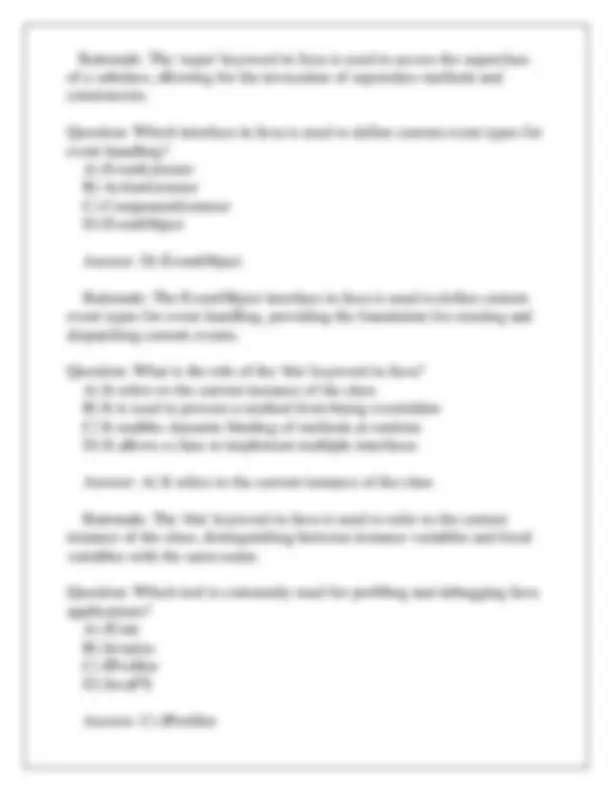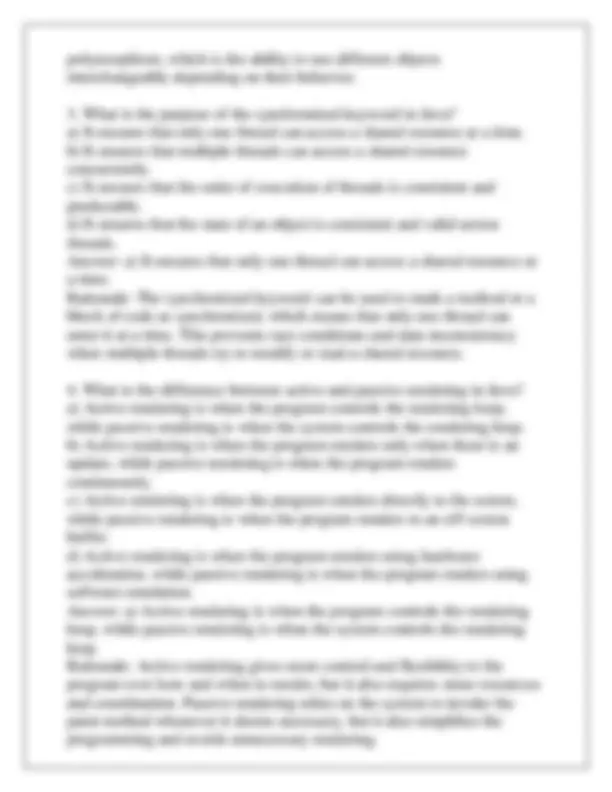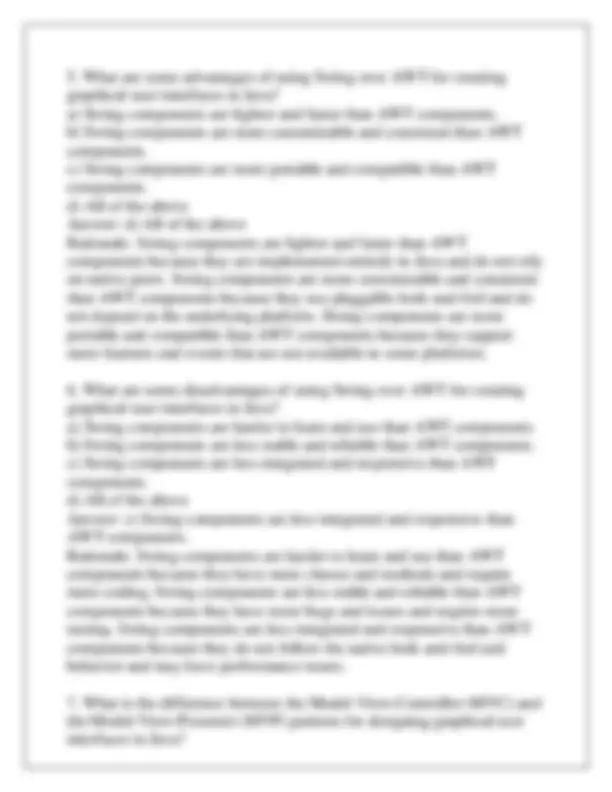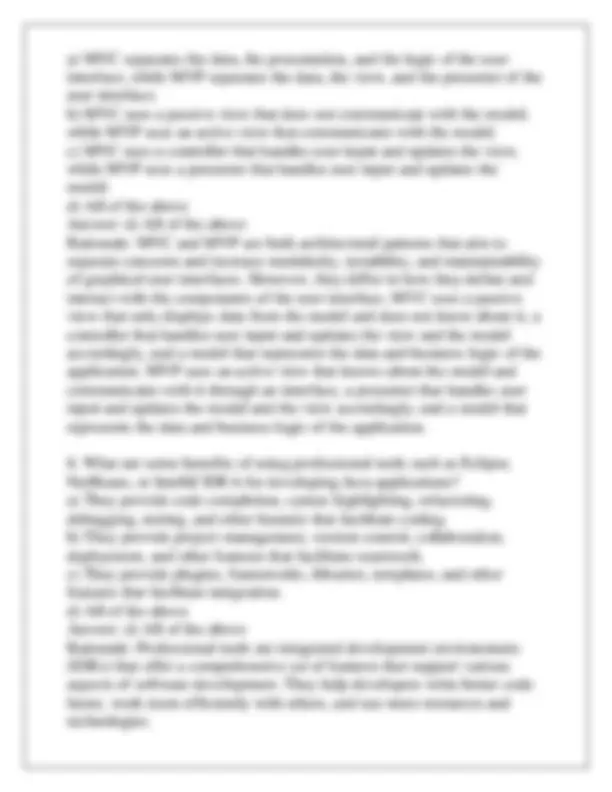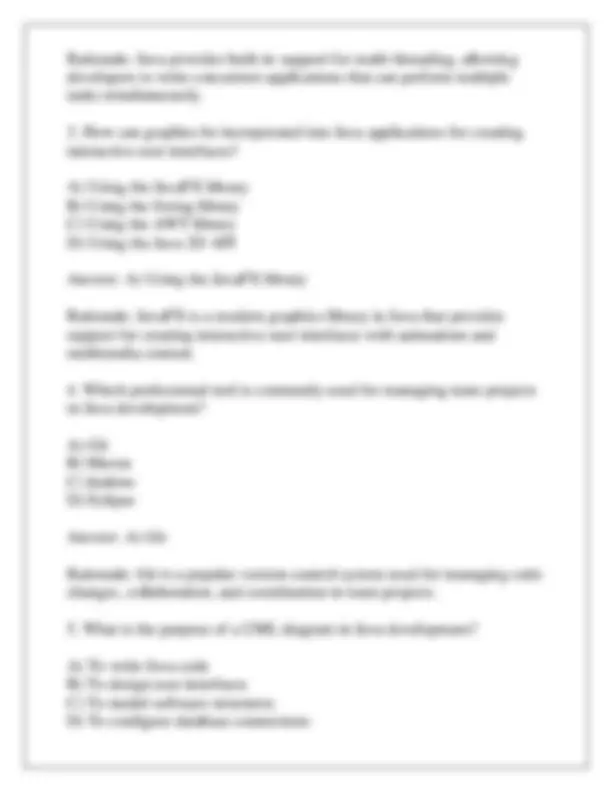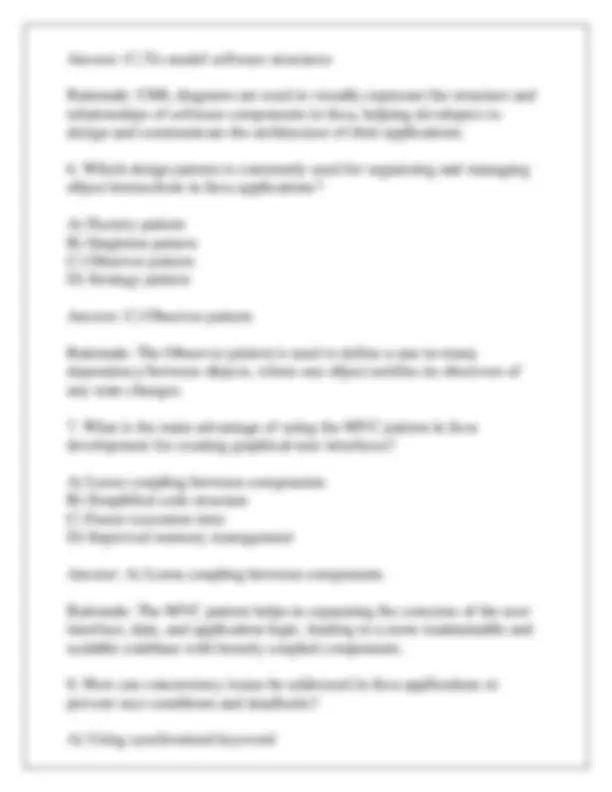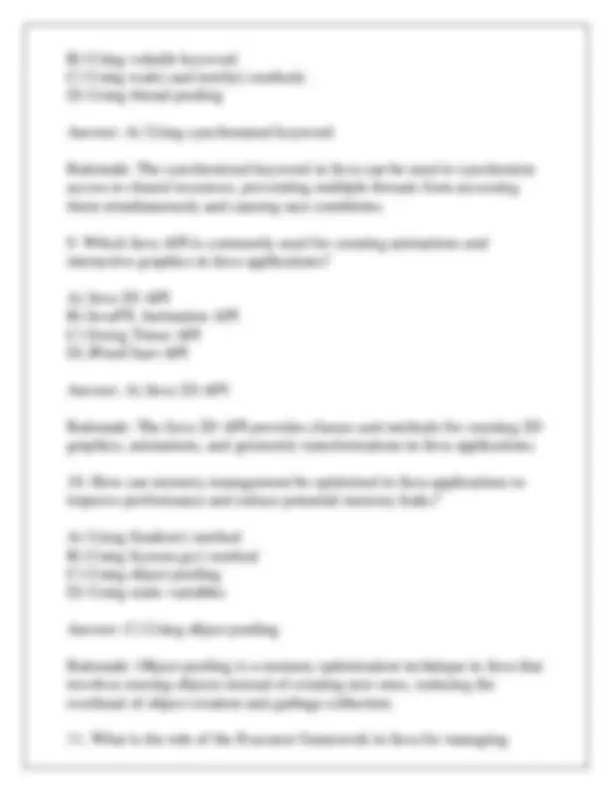Download Java Programming: Abstract, Synchronized, GridLayout, Volatile, Polymorphism, Interfaces, and more Exams Computer Science in PDF only on Docsity!
CSCI 201L
Principles of Software
Development Review
Exam
Q & A
Question: Which of the following best describes the concept of inheritance in Object-oriented programming? A) It allows a class to inherit the properties and behaviors of another class B) It enables a class to override the properties of another class C) It restricts access to certain class members D) It allows a class to implement multiple interfaces Answer: A) It allows a class to inherit the properties and behaviors of another class Rationale: Inheritance is a fundamental concept in Object-oriented programming, allowing a class to inherit the properties and behaviors of another class, promoting code reusability and establishing a hierarchical relationship between classes. Question: Which keyword is used to implement abstraction in Java? A) abstract B) final C) static D) interface Answer: A) abstract Rationale: The 'abstract' keyword is used to implement abstraction in Java, allowing the creation of abstract classes and methods that provide a blueprint for other classes to implement. Question: What is the purpose of the 'synchronized' keyword in Java? A) It ensures that only one instance of a class can be created B) It synchronizes the execution of concurrent threads C) It allows a class to access private members of another class D) It enables dynamic binding of methods at runtime Answer: B) It synchronizes the execution of concurrent threads Rationale: The 'synchronized' keyword in Java is used to control the
source code. Question: What does the term "polymorphism" refer to in the context of Object-oriented programming? A) It allows a class to inherit from multiple superclasses B) It enables a method to perform different actions based on the object calling it C) It restricts the visibility of class members to the same package D) It ensures that a method cannot be overridden by a subclass Answer: B) It enables a method to perform different actions based on the object calling it Rationale: Polymorphism in Java allows a method to perform different actions based on the object that is calling it, promoting flexibility and extensibility in the code. Question: Which of the following is an example of a checked exception in Java? A) NullPointerException B) ArrayIndexOutOfBoundsException C) IOException D) IllegalArgumentException Answer: C) IOException Rationale: IOException is an example of a checked exception in Java, which means that it must be either caught or declared in the method in which it is thrown. Question: What is the purpose of the 'super' keyword in Java? A) It is used to access the superclass of a subclass B) It specifies that a class cannot be instantiated C) It denotes a method that is implemented in the superclass D) It allows a subclass to override a method in the superclass Answer: A) It is used to access the superclass of a subclass
Rationale: The 'super' keyword in Java is used to access the superclass of a subclass, allowing for the invocation of superclass methods and constructors. Question: Which interface in Java is used to define custom event types for event handling? A) EventListener B) ActionListener C) ComponentListener D) EventObject Answer: D) EventObject Rationale: The EventObject interface in Java is used to define custom event types for event handling, providing the foundation for creating and dispatching custom events. Question: What is the role of the 'this' keyword in Java? A) It refers to the current instance of the class B) It is used to prevent a method from being overridden C) It enables dynamic binding of methods at runtime D) It allows a class to implement multiple interfaces Answer: A) It refers to the current instance of the class Rationale: The 'this' keyword in Java is used to refer to the current instance of the class, distinguishing between instance variables and local variables with the same name. Question: Which tool is commonly used for profiling and debugging Java applications? A) JUnit B) Javadoc C) JProfiler D) JavaFX Answer: C) JProfiler
multiple tasks Rationale: Thread pooling in Java involves creating a fixed number of threads to execute multiple tasks, improving performance by reusing threads and managing their lifecycle efficiently.
- What is the main difference between inheritance and composition in object-oriented programming? a) Inheritance is a way of reusing code from a superclass, while composition is a way of combining objects of different classes. b) Inheritance is a way of creating a hierarchy of classes, while composition is a way of creating a network of classes. c) Inheritance is a way of defining a new class based on an existing class, while composition is a way of defining a new class based on multiple existing classes. d) Inheritance is a way of specifying the common behavior of a group of classes, while composition is a way of specifying the specific behavior of a single class. Answer: c) Inheritance is a way of defining a new class based on an existing class, while composition is a way of defining a new class based on multiple existing classes. Rationale: Inheritance allows a subclass to inherit the fields and methods of a superclass, while composition allows a class to contain references to objects of other classes and delegate some functionality to them.
- What is the benefit of using interfaces in Java? a) Interfaces allow multiple inheritance in Java. b) Interfaces allow polymorphism in Java. c) Interfaces allow encapsulation in Java. d) Interfaces allow abstraction in Java. Answer: b) Interfaces allow polymorphism in Java. Rationale: Interfaces define a set of abstract methods that can be implemented by different classes, which can then be treated as the same type by using the interface as the reference type. This enables
polymorphism, which is the ability to use different objects interchangeably depending on their behavior.
- What is the purpose of the synchronized keyword in Java? a) It ensures that only one thread can access a shared resource at a time. b) It ensures that multiple threads can access a shared resource concurrently. c) It ensures that the order of execution of threads is consistent and predictable. d) It ensures that the state of an object is consistent and valid across threads. Answer: a) It ensures that only one thread can access a shared resource at a time. Rationale: The synchronized keyword can be used to mark a method or a block of code as synchronized, which means that only one thread can enter it at a time. This prevents race conditions and data inconsistency when multiple threads try to modify or read a shared resource.
- What is the difference between active and passive rendering in Java? a) Active rendering is when the program controls the rendering loop, while passive rendering is when the system controls the rendering loop. b) Active rendering is when the program renders only when there is an update, while passive rendering is when the program renders continuously. c) Active rendering is when the program renders directly to the screen, while passive rendering is when the program renders to an off-screen buffer. d) Active rendering is when the program renders using hardware acceleration, while passive rendering is when the program renders using software emulation. Answer: a) Active rendering is when the program controls the rendering loop, while passive rendering is when the system controls the rendering loop. Rationale: Active rendering gives more control and flexibility to the program over how and when to render, but it also requires more resources and coordination. Passive rendering relies on the system to invoke the paint method whenever it deems necessary, but it also simplifies the programming and avoids unnecessary rendering.
a) MVC separates the data, the presentation, and the logic of the user interface, while MVP separates the data, the view, and the presenter of the user interface. b) MVC uses a passive view that does not communicate with the model, while MVP uses an active view that communicates with the model. c) MVC uses a controller that handles user input and updates the view, while MVP uses a presenter that handles user input and updates the model. d) All of the above Answer: d) All of the above Rationale: MVC and MVP are both architectural patterns that aim to separate concerns and increase modularity, testability, and maintainability of graphical user interfaces. However, they differ in how they define and interact with the components of the user interface. MVC uses a passive view that only displays data from the model and does not know about it, a controller that handles user input and updates the view and the model accordingly, and a model that represents the data and business logic of the application. MVP uses an active view that knows about the model and communicates with it through an interface, a presenter that handles user input and updates the model and the view accordingly, and a model that represents the data and business logic of the application.
- What are some benefits of using professional tools such as Eclipse, NetBeans, or IntelliJ IDEA for developing Java applications? a) They provide code completion, syntax highlighting, refactoring, debugging, testing, and other features that facilitate coding. b) They provide project management, version control, collaboration, deployment, and other features that facilitate teamwork. c) They provide plugins, frameworks, libraries, templates, and other features that facilitate integration. d) All of the above Answer: d) All of the above Rationale: Professional tools are integrated development environments (IDEs) that offer a comprehensive set of features that support various aspects of software development. They help developers write better code faster, work more efficiently with others, and use more resources and technologies.
- What are some drawbacks of using professional tools such as Eclipse, NetBeans, or IntelliJ IDEA for developing Java applications? a) They require more memory, disk space, processing power, and other resources than simple editors or compilers. b) They have more complexity, configuration, compatibility, and other issues than simple editors or compilers. c) They may introduce dependencies, limitations, biases, or other problems than simple editors or compilers. d) All of the above Answer: d) All of the above Rationale: Professional tools are integrated development environments (IDEs) that offer a comprehensive set of features that support various aspects of software development. However, they also have some disadvantages compared to simple editors or compilers. They consume more resources and may affect performance or availability. They have more complexity and may require more learning or troubleshooting. They may introduce dependencies or limitations that affect portability or flexibility. They may also influence developers' choices or habits in ways that are not optimal or desirable.
- What is the difference between programming in-the-small and programming in-the-large in Java? a) Programming in-the-small is when you write simple programs that solve specific problems, while programming in-the-large is when you write complex systems that solve general problems. b) Programming in-the-small is when you write programs that focus on algorithms and data structures, while programming in-the-large is when you write programs that focus on architecture and design patterns. c) Programming in-the-small is when you write programs that use procedural or functional paradigms, while programming in-the-large is when you write programs that use object-oriented or concurrent paradigms. d) All of the above Answer: b) Programming in-the-small is when you write programs that focus on algorithms and data structures, while programming in-the-large is when you write programs that focus on architecture and design patterns. Rationale: Programming in-the-small and programming in-the-large are
Rationale: Java provides built-in support for multi-threading, allowing developers to write concurrent applications that can perform multiple tasks simultaneously.
- How can graphics be incorporated into Java applications for creating interactive user interfaces? A) Using the JavaFX library B) Using the Swing library C) Using the AWT library D) Using the Java 2D API Answer: A) Using the JavaFX library Rationale: JavaFX is a modern graphics library in Java that provides support for creating interactive user interfaces with animations and multimedia content.
- Which professional tool is commonly used for managing team projects in Java development? A) Git B) Maven C) Jenkins D) Eclipse Answer: A) Git Rationale: Git is a popular version control system used for managing code changes, collaboration, and coordination in team projects.
- What is the purpose of a UML diagram in Java development? A) To write Java code B) To design user interfaces C) To model software structures D) To configure database connections
Answer: C) To model software structures Rationale: UML diagrams are used to visually represent the structure and relationships of software components in Java, helping developers to design and communicate the architecture of their applications.
- Which design pattern is commonly used for organizing and managing object interactions in Java applications? A) Factory pattern B) Singleton pattern C) Observer pattern D) Strategy pattern Answer: C) Observer pattern Rationale: The Observer pattern is used to define a one-to-many dependency between objects, where one object notifies its observers of any state changes.
- What is the main advantage of using the MVC pattern in Java development for creating graphical user interfaces? A) Loose coupling between components B) Simplified code structure C) Faster execution time D) Improved memory management Answer: A) Loose coupling between components Rationale: The MVC pattern helps in separating the concerns of the user interface, data, and application logic, leading to a more maintainable and scalable codebase with loosely coupled components.
- How can concurrency issues be addressed in Java applications to prevent race conditions and deadlocks? A) Using synchronized keyword
concurrent tasks in a thread pool? A) Distribute tasks to worker threads B) Handle exceptions in threads C) Synchronize access to shared resources D) Create new threads dynamically Answer: A) Distribute tasks to worker threads Rationale: The Executor framework in Java provides a high-level interface for managing concurrent tasks by distributing them to worker threads in a thread pool, improving efficiency and scalability.
- How can Java Reflection be used in professional Java development to dynamically inspect and manipulate class objects at runtime? A) To create new instances of classes B) To access private fields and methods C) To perform type casting D) To serialize and deserialize objects Answer: B) To access private fields and methods Rationale: Java Reflection allows developers to access private fields and methods of class objects at runtime, enabling dynamic inspection and manipulation of class structures.
- Which IDE (Integrated Development Environment) is commonly used by professional Java developers for writing, testing, and debugging Java applications? A) IntelliJ IDEA B) NetBeans C) JDeveloper D) BlueJ Answer: A) IntelliJ IDEA
Rationale: IntelliJ IDEA is a popular IDE among professional Java developers for its powerful features, intelligent code editing, debugging tools, and support for various Java frameworks and technologies.
- How can unit testing be integrated into Java development to ensure the reliability and quality of Java code? A) Using JUnit framework B) Using Mockito framework C) Using TestNG framework D) Using Selenium framework Answer: A) Using JUnit framework Rationale: JUnit is a widely used unit testing framework in Java for writing and executing test cases to validate the behavior and correctness of Java code, ensuring reliable and high-quality software.
- What is the main advantage of using the Builder design pattern in Java for creating complex object structures? A) Simplified object creation B) Improved code readability C) Better memory utilization D) Enhanced performance Answer: A) Simplified object creation Rationale: The Builder design pattern in Java simplifies the creation of complex object structures by separating the construction process from the representation, allowing for flexible and fluent object initialization without exposing the object's internal details.

